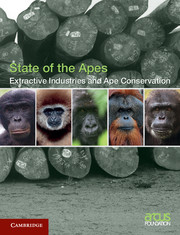Book contents
- Frontmatter
- Foreword
- Contents
- The Arcus Foundation
- Notes to readers
- Acknowledgments
- Photo
- Introduction
- Section 1
- 1 From global to local: the megatrends at the interface of apes and industry and the case of trade, law, and finance
- 2 Land tenure: industry, ape conservation, and communities
- 3 Ecological impacts of extractive industries on ape populations
- 4 Avoiding the chainsaws: industrial timber extraction and apes
- 5 Mining/oil extraction and ape populations and habitats
- 6 Artisanal and small-scale mining and apes
- 7 The bigger picture: indirect impacts of extractive industries on apes and ape habitat
- 8 Case studies of national responses to the impacts of extractive industries on great apes
- Section 2
- Annexes
- Acronyms and abbreviations
- Glossary
- References
- Index
5 - Mining/oil extraction and ape populations and habitats
Published online by Cambridge University Press: 05 June 2014
- Frontmatter
- Foreword
- Contents
- The Arcus Foundation
- Notes to readers
- Acknowledgments
- Photo
- Introduction
- Section 1
- 1 From global to local: the megatrends at the interface of apes and industry and the case of trade, law, and finance
- 2 Land tenure: industry, ape conservation, and communities
- 3 Ecological impacts of extractive industries on ape populations
- 4 Avoiding the chainsaws: industrial timber extraction and apes
- 5 Mining/oil extraction and ape populations and habitats
- 6 Artisanal and small-scale mining and apes
- 7 The bigger picture: indirect impacts of extractive industries on apes and ape habitat
- 8 Case studies of national responses to the impacts of extractive industries on great apes
- Section 2
- Annexes
- Acronyms and abbreviations
- Glossary
- References
- Index
Summary
Introduction
The extractive industries overlap extensively with ape habitat across Asia and Africa. In both regions, these industries are growing in intensity and scale, with increasing amounts of exploration and development/production in areas of land previously unexploited. Africa, in particular, is experiencing an unprecedented surge in mineral and hydrocarbon development, and the landscape is quite literally being turned upside down in search of the materials and energy that drive the global economy. The significant peak in exploration in the past decade was from 2000–08, with a gradual but significant slow-down over the past 5 years (J. Suter, personal communication, 2013). Although the mineral and hydrocarbon industry directly affects the landscape at a different scale to that of the forestry industry, broad-scale changes to habitat structure and composition can result from both direct and indirect impacts generated during the project exploration, development, operation, and closeout phases of mineral/hydrocarbon projects.
Far less is known about the impacts of mining and hydrocarbon project development (including exploration, analysis, site selection, construction, operations, closure, and post-closure) than about the impacts of logging. Chapter 4 explores the impacts of logging in greater detail. There are few published studies on the impacts of mining, oil, and gas projects (exploration and development) on African or Asian ape populations (Kormos and Kormos, 2011b). It is evident, however, that mining and hydrocarbon exploration and development processes are impacting the habitats and populations of all taxa of apes both directly and indirectly.
- Type
- Chapter
- Information
- Extractive Industries and Ape Conservation , pp. 126 - 161Publisher: Cambridge University PressPrint publication year: 2014



